Reed Flute Cave is a stunning karst cave located in the northwest suburbs of Guilin, just 5 kilometers from the city center. This scenic area primarily features the exploration of its magnificent cave system, complemented by the surrounding rural landscapes.
As a masterpiece of nature formed over 180 million years, the cave dazzles visitors with its breathtaking stalactites, stalagmites, and stone curtains. Walking through its illuminated chambers feels like stepping into a mythical wonderland, earning it the title “The Palace of Natural Art.”
Reed Flute Cave Facts
- Type: Geologic Formations, Nature & Cave
- Address: Reed Flute Cave, 1 Ludi Rd, Guilin
- Size: 240 meters deep
- Tour length: 500 meters
- Best Seasons: Spring, Summer and Autumn, especially Apr to Oct
- Recommended Visiting Time: 1-2 hours
- Opening Hours: 07:30 – 18:00
- Ticket Price: CNY 90. Trip.com Discount
Reed Flute Cave History
Reed Flute Cave derives its name from the special reeds (Phragmites) at its entrance that local people traditionally crafted into flutes. Historical records indicate the cave was known as early as the Tang Dynasty (618-907 AD), when visitors first began leaving their marks within its chambers.
The cave walls preserve 77 precious inscriptions and poems carved between 792 AD (Tang Zhenyuan era) and the Song Dynasty (960–1279 AD). The oldest inscription, dating to 792 AD, makes this one of China’s earliest documented tourist attractions.

After being rediscovered in 1959, the cave underwent careful development and opened to visitors in 1962. Since then, thoughtful additions like tasteful lighting, walkways, and visitor facilities have been installed to enhance the experience while protecting the delicate formations. Today, the cave harmoniously blends its ancient wonders with modern amenities including a tea house and viewing pavilions, offering visitors both natural splendor and cultural enrichment.
As the world’s most visited karst attraction, Reed Flute Cave holds the distinguished title of “State Guest Cave.” Its extraordinary geological wonders have welcomed numerous Chinese leaders and international dignitaries, including U.S. Presidents Richard Nixon and Jimmy Carter, adding a modern chapter to its storied history.
How Was Reed Flute Cave Formed?
Reed Flute Cave’s extraordinary formations were crafted by nature over millions of years. Originally an ancient underground lake, the cave emerged as tectonic shifts elevated the terrain and lowered water levels. As groundwater seeped through fractures in the limestone, it dissolved calcium carbonate and later deposited these minerals upon reaching the cavern. This slow dance of dissolution and crystallization—persisting for nearly a million years—created the cave’s breathtaking stalactites (descending from ceilings), stalagmites (rising from floors), and stone pillars (their eventual union).
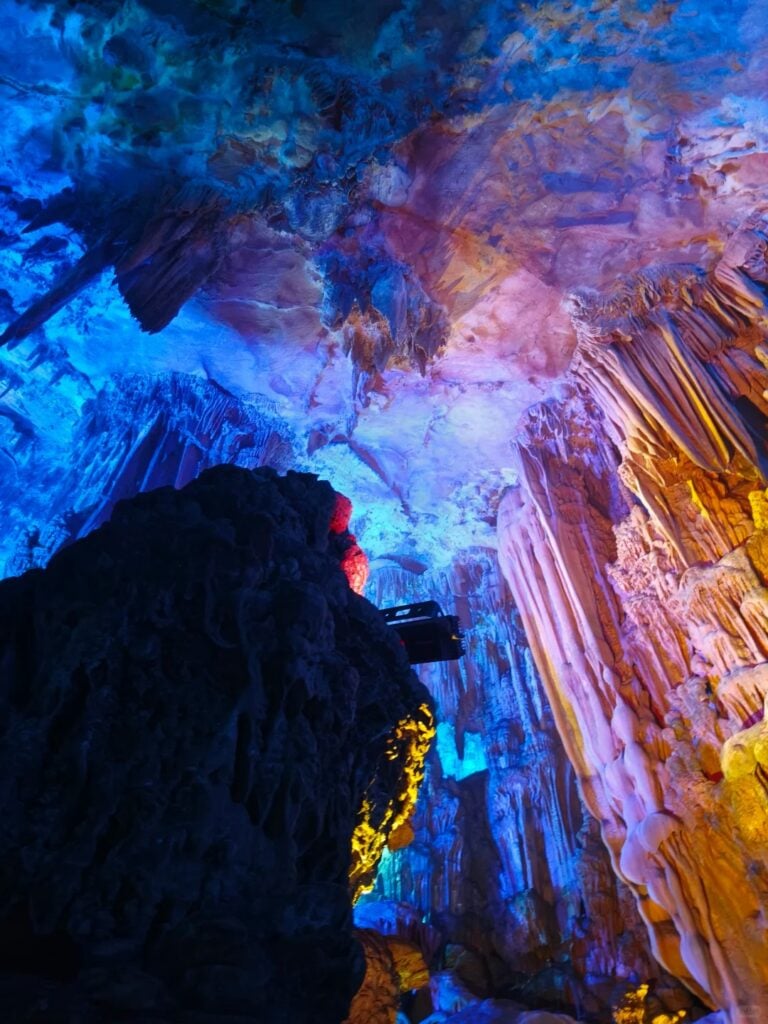
What to See Inside Reed Flute Cave?
Lion Rock and Sunrise (Pinyin: Shilingchaoxia 狮岭朝霞)
As the very first spectacle greeting visitors, this breathtaking scene comes alive at dawn when stalactite formations transform into a pride of lions dancing in golden sunlight. The majestic centerpiece – a towering “lion king” – oversees playful cubs amidst a stone forest draped with vine-like formations. Bathed in radiant hues, this mineral masterpiece pulsates with life, perfectly capturing nature’s artistic brilliance through its dynamic limestone sculptures.
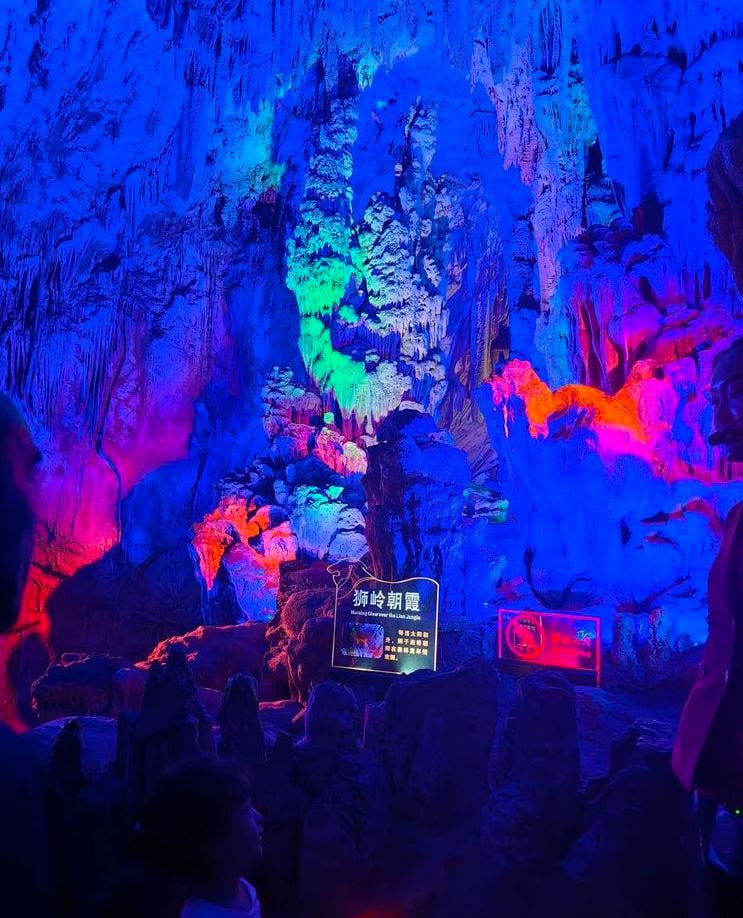
Tower-shaped Pine (Pinyin: Tasongaoxue 塔松傲雪)
Among Reed Flute Cave’s wonders stands a remarkable stalagmite resembling a snow-laden pine tree. Its layered calcite crystals perfectly mimic thick snow covering the branches, embodying the Chinese ideal of resilience expressed in the saying “Pines turn greener after snow.” Nearby, a charming snowman-shaped formation appears to be bundling up against the chill, with its “hands” tucked snugly into its “pockets” – both exquisite examples of nature’s patient artistry through mineral deposition.
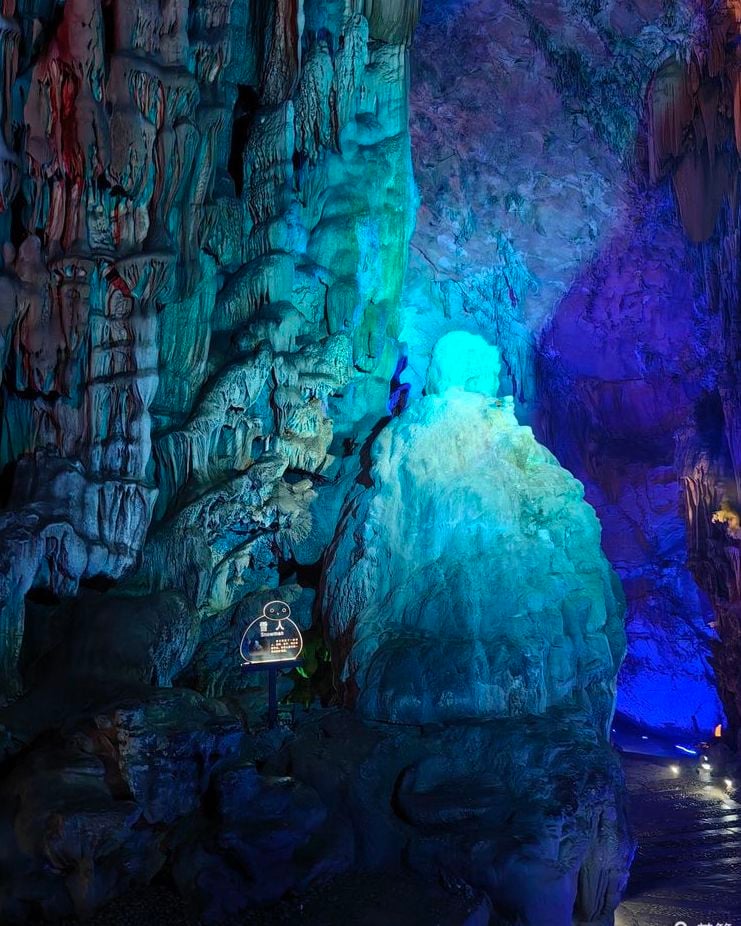
Crystal Palace (Pinyin: Shuijingong 水晶宫)
As the crown jewel of Reed Flute Cave, this magnificent 93-meter-wide, 18-meter-high oval chamber dazzles visitors with its spacious interior resembling a mythical undersea palace. Dominating the upper left wall, a colossal stone “palace lantern” casts ethereal hues across the vaulted ceiling, where mineral formations mimic frozen sea creatures – jellyfish fleeing in panic, a petrified seashell, and a carp seemingly diving into the earth. The chamber’s unusually smooth floor and intact ceiling create a regal atmosphere worthy of the Dragon King’s legendary abode from Chinese folklore.


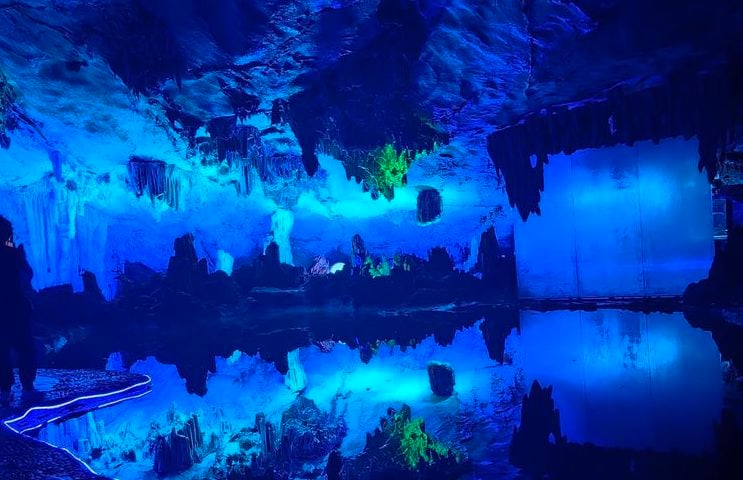
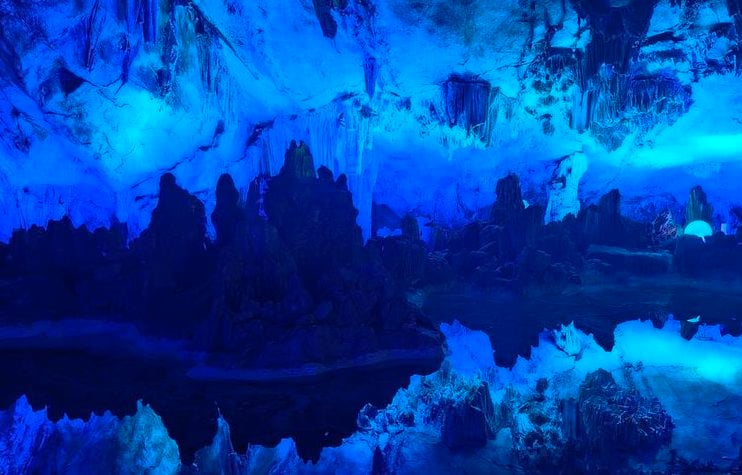
Waterfall Down the High Gorge
This spectacular rock formation resembles a giant waterfall suspended in mid-air. The smooth stone surface stretches upward like a frozen cascade, creating a breathtaking natural wonder inside the cave.
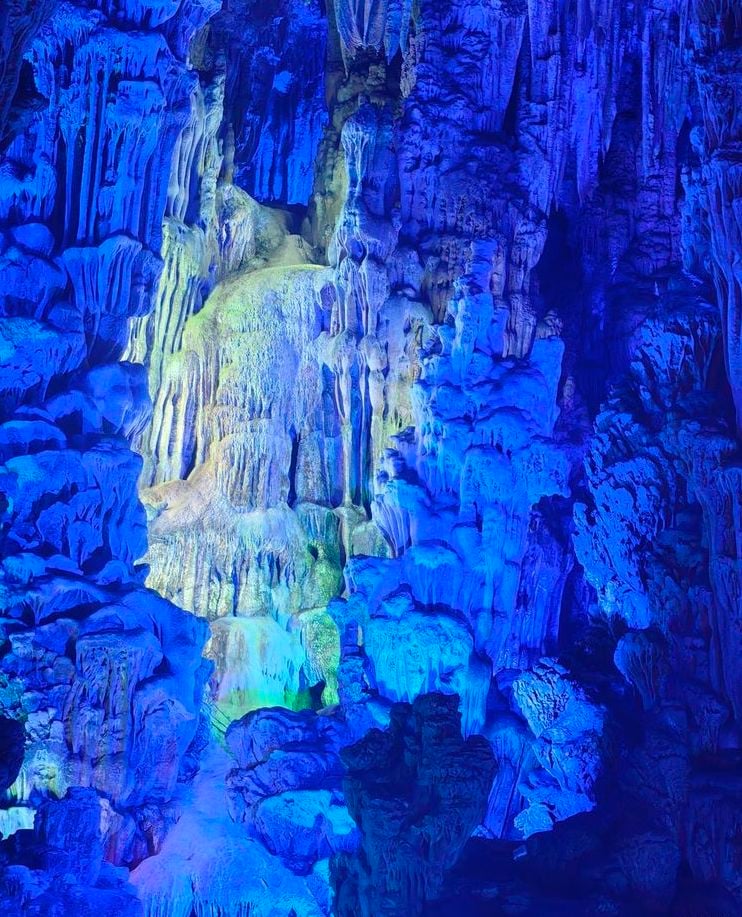
Sky-Scraping Twin (Pinyin: Shuangzhuqingtian 双柱擎天)
These two majestic stone pillars tower over Reed Flute Cave’s primeval forest, soaring dramatically toward the ceiling. Though appearing identical at first glance, closer inspection reveals subtle differences. Both stand tall and straight, truly living up to their name as the “Sky-Scraping Twins”.
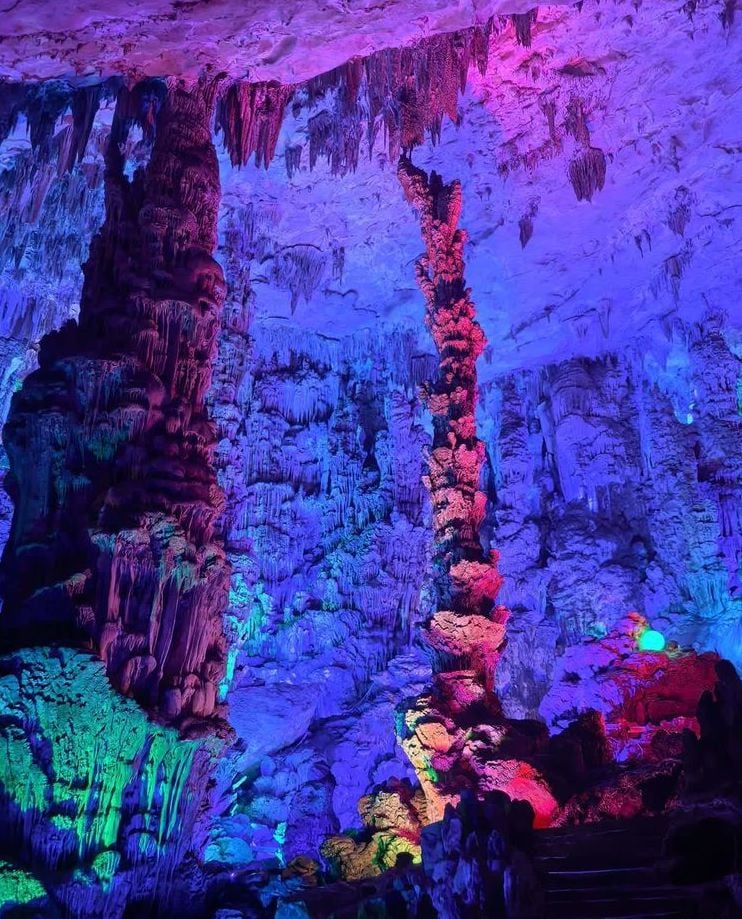
Inscriptions on the Cave Wall
The cave walls preserve 77 historic inscriptions and poems dating back to the Tang Dynasty (618-907 AD), making this one of China’s earliest documented tourist sites. These ancient “wall posts” – ranging from travelers’ signatures to poetic impressions – offer fascinating glimpses into centuries of visitors marveling at the same spectacular formations we admire today.
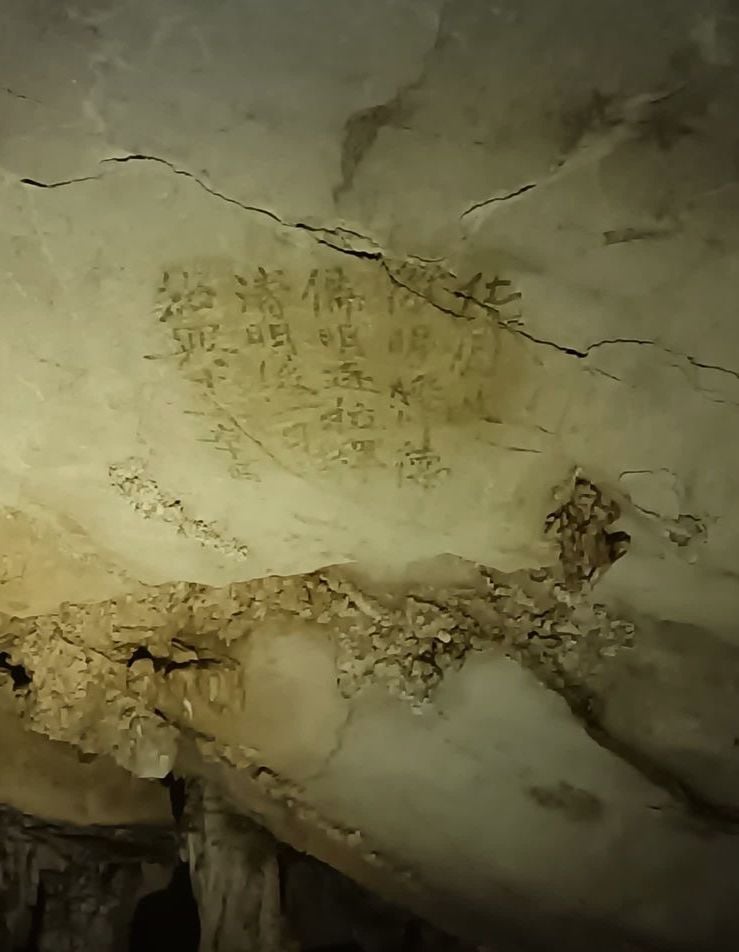
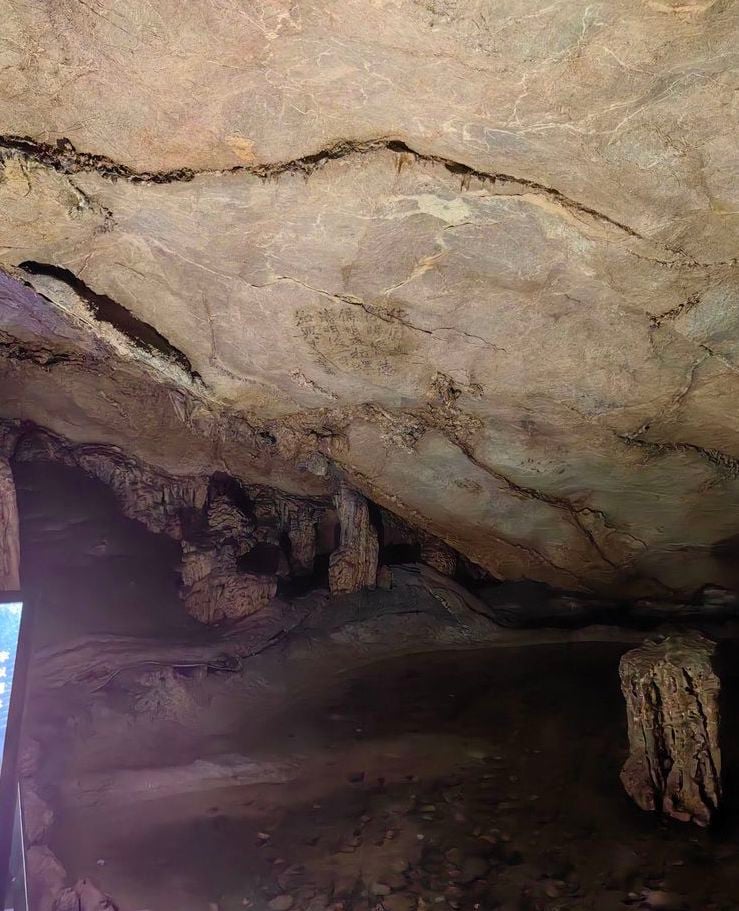
Where to Go Sightseeing outside Reed Flute Cave?
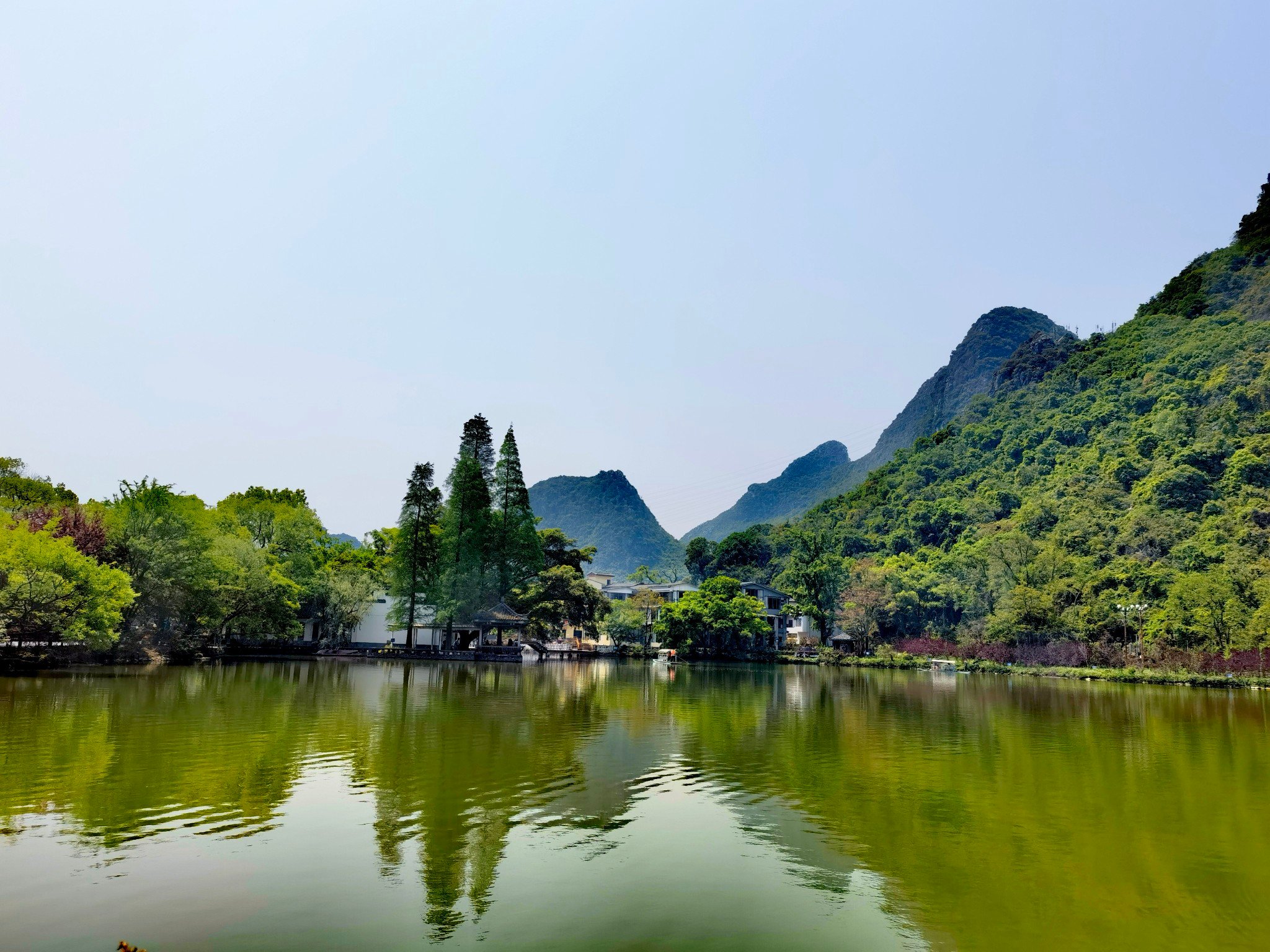
While Reed Flute Cave is the highlight, the Reed Flute Scenic Area offers several other beautiful sights:
- Houshan Mountain: Forms the core scenic area with Reed Flute Cave, featuring typical karst peaks and rugged cliffs.
- Taohua River (Peach Blossom River): A picturesque waterway lined with flowering trees, complemented by traditional waterside pavilions and zigzag bridges.
- Feiluan Bridge: Located about 5km away, this ancient bridge offers access to wetlands and karst landscapes, ideal for camping and nature exploration.
- Fanglian Pond: A serene lake surrounded by willow trees, especially beautiful in spring when peach blossoms bloom, creating a classic Chinese pastoral scene.
Each site contributes to the area’s harmonious blend of karst formations and water landscapes that characterize Guilin’s famous scenery.
Best Time to visit Reed Flute Cave
Reed Flute Cave is a great place to visit all year round, but the best time is from April to October. The subtropical monsoon climate is mild and pleasant, with long summers and short winters, abundant sunshine, and an average annual temperature of around 19 degrees Celsius. The four seasons are distinct, with neither extreme cold nor extreme heat.
Travel Tips for Reed Flute Cave Visit
To ensure you have the most enjoyable and comfortable experience at Reed Flute Cave, here are some helpful suggestions:
- Visit on weekday mornings to avoid crowds
- Allow 1-2 hours for your tour
- Follow the U-shaped route through the cave
- Bring a flashlight and wear non-slip shoes
- Photography is allowed (no flash) – use high ISO settings
- Bargain when buying reed flutes from outside vendors
How to get to Reed Flute Cave
- Take bus No. 3 and get off at Reed Flute Cave Station;
- Take bus No. 213 and get off at the Reed Flute Cave parking station;
- Take a taxi to the Reed Flute Cave Ticketing Center and walk up the mountain for a few minutes to reach the cave entrance.
Note: City Sightseeing Bus Line 1 no longer passes Reed Flute Cave since August 8, 2024.
Reed Flute Cave Ticket Price & Opening Hours
Book Your Ticket Now| Entrance Fee | 1. CNY 90; 2. CNY45 for minors aged 7-18 and seniors over 70. 3. Free for children under 1.2 meters and no more than 6 years old. |
| Opening Hours | 07:30 – 18:00 |
Reed Flute Cave VS Silver Cave
Both Reed Flute Cave and Silver Cave are celebrated for their spectacular stalactites and stalagmites, yet each possesses unique charms. Reed Flute Cave is famed as the “Palace of Natural Art,” where ancient Tang Dynasty inscriptions mingle with vibrantly illuminated formations, creating a historical and artistic atmosphere. Silver Cave earns its name from shimmering white calcite crystals that blanket its grand chambers, particularly in breathtaking formations like the “Snow Mountain” waterfall. While Reed Flute Cave enchants with its cultural legacy and intimate scale, Silver Cave awes visitors with its pristine, silvery grandeur and expansive underground landscapes – two magnificent yet distinct interpretations of nature’s subterranean artistry.